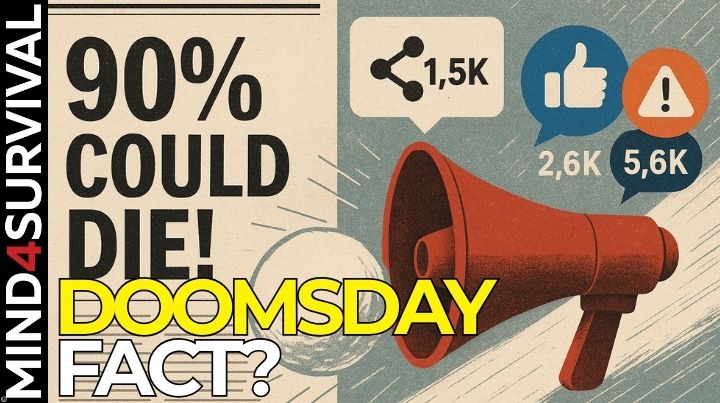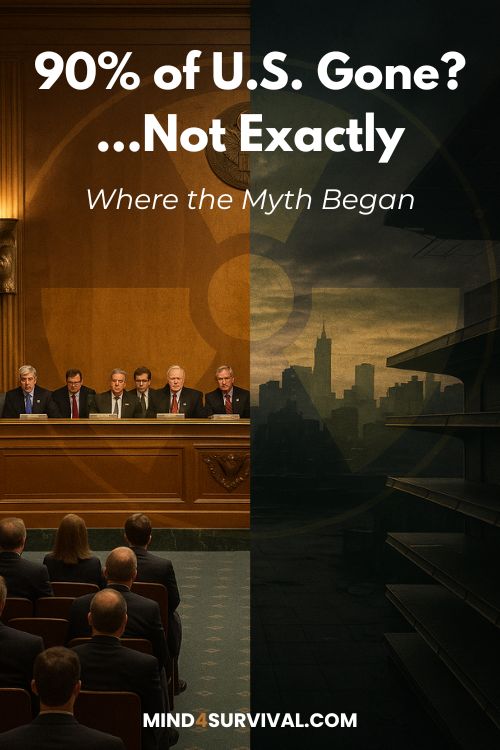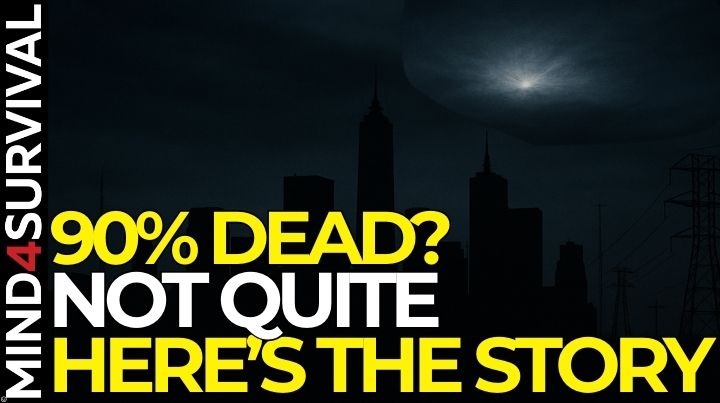Podcast: Play in new window | Download
You’ve probably heard it before: that 90% of Americans would die within a year of an EMP attack. It’s one of the most quoted numbers in all of preparedness.
But that number didn’t come from a study or model. It came from a single sentence in a 2005 Senate hearing. It wasn’t a forecast—it was one extreme of a range, from no deaths to full collapse.
Still, over time, the 90% death rate became gospel. And too many people now treat it as an inevitable outcome, especially in the prepper community.
I’m not an EMP physicist—and I’m not saying it couldn’t happen. I’m saying it was never a guarantee. Planning for the worst is smart, but regurgitating the 90% as a guaranteed outcome isn’t. It’s one possibility among many EMP possibilities, and smart preparedness is built on facts, not assumptions.
This article walks through where the number came from, how it spread, and why context—and critical thinking—still matter.
TL;DRThe 90% EMP death toll claim came from a 2005 Senate hearing as a worst-case scenario—one extreme on a wide range from no deaths to societal collapse—it was never supported by scientific modeling or data.
Quick Look at What You’ll Learn
What the 90% EMP Statistic Refers To
The 90% number refers to a projected worst-case scenario in which a high-altitude nuclear EMP detonation disables the U.S. power grid, leading to a cascading collapse of critical infrastructure.
Under this scenario, the country would lose access to:
- Electricity (long-term grid failure)
- Transportation and fuel delivery
- Water treatment and distribution
- Food production and refrigeration
- Healthcare systems and medications
The 90% figure estimates how many Americans could die within 12 months due to starvation, disease, exposure, and civil breakdown, not the EMP blast itself.
Where the 90% Number Did Not Come From
Not from William Forstchen’s One Second After
The 2009 novel One Second After by William Forstchen helped popularize the severity of EMP threats in fiction. It depicts a U.S. town descending into collapse after an EMP, with a death toll in the tens of millions.
However, despite what some believe, the novel never mentions the 90% statistic. Many people assume it originated here because the book was cited during congressional hearings, but that is incorrect.
Not from the EMP Commission’s Official Reports
In 2008, during a House Armed Services Committee hearing on the EMP threat, Representative Roscoe Bartlett asked if the mass fatality scenario in One Second After was realistic. Dr. William Graham, Chairman of the EMP Commission, replied:
It’s in the range of possibilities.
That exchange introduced the 90% figure into the congressional record during a 2008 House Armed Services Committee hearing, not in the 2008 EMP Commission report itself. In fact, the EMP Commission never published a study or model confirming that number in any of its official reports. source
Where the 90% EMP Statistic Actually Started
The earliest known use of the 90% figure came in March 2005. During a U.S. Senate hearing on the EMP threat, physicist Dr. Lowell Wood testified:
The parameter space is kind of as big as all outdoors… It goes all the way from… a blackout, with no loss of life… to something which would literally destroy the American nation… might cause the deaths of 90 percent of its people… and would set us back a century or more. source
This was not a scientifically studied prediction. It was not based on simulation or modeling. It was presented as the worst case on a wide spectrum of possible outcomes.
That spectrum ranged from “no deaths” to “90% mortality”. But over time, only the high end of that range was remembered.
Why the 90% Figure Stuck
By the time the 90% number hit mainstream prepper circles, its context had mostly faded. What began as one end of a wide spectrum became treated as a central forecast. And over time, that worst-case scenario hardened into conventional wisdom and a dystopian fact in many people’s minds.

Several reasons explain why the 90% figure became so prominent:
- It’s shocking. Numbers that evoke fear are more likely to spread and be remembered.
- It was cited by high-profile figures. Newt Gingrich and other national security voices endorsed it repeatedly in speeches and articles.
- It became a media shorthand. Major outlets repeated the statistic in their EMP coverage. source
- It fits a compelling narrative. The idea of a high-tech society collapsing overnight taps into deeply held concerns about dependency and fragility.
Is There Scientific Support for the 90% Number?
In short: no.
A 2019 peer-reviewed study published in Energy, Sustainability and Society investigated the origins of the 90% EMP fatality claim and concluded:
There is no published model disclosing how these numbers were arrived at, nor are we able to validate a primary source for this claim.
The authors noted that the number is often repeated, but always sourced to expert testimony, not to empirical analysis or modeling.
What a Large-Scale EMP Could Lead To
While it’s true that a large-scale EMP could have devastating consequences, it’s important not to confuse it with a coronal mass ejection (CME). A CME is a solar phenomenon that disrupts power infrastructure, especially high-voltage transformers, but it does not outright destroy cars or handheld electronics. EMPs are more severe in that regard, but also more complex and variable in impact. Treating them as identical threats oversimplifies the risks and misguides planning.
Experts and national security professionals agree that a widespread EMP attack or solar superstorm would have severe, long-term consequences.
These could include:
- Grid outages lasting weeks, months, or even longer
- Breakdown of communications, logistics, and emergency services
- Food and water shortages
- Increased mortality from lack of medical care
- Mass migration and civil unrest
The actual death toll would depend on many factors, including season, geography, disaster response, and community resilience.
The 90% figure represents an extreme scenario—not a default outcome.
The Bottom Line on the EMP 90% Statistic
The “90 percent of Americans would die” claim was never meant to be taken as a stand-alone fact. It started as one man’s reference point on a wide spectrum of possibilities. Over time, it was repeated, quoted, amplified, and eventually treated as gospel.
It’s not a lie. But it’s not a forecast, either.
It’s a warning.
And warnings are meant to be understood, not just feared.
If you’re serious about preparedness, don’t start with half-truths. Whenever possible, start with whole truths and facts. Start with a decision-making process charged with an accurate perspective.
Being ready isn’t about believing in the worst, just because it’s the worst.
It’s about making sure you have the whole picture, so that you can make an effective decision, no matter what scenario shows up.
FAQ: EMP and the 90% Statistic
Did the U.S. government predict that 90% of Americans would die from an EMP?
No. The 90% figure was mentioned in a 2005 Senate hearing as one extreme of a possible outcome—not as a forecast or official prediction.
Is the 90% EMP fatality number supported by science?
No. A 2019 peer-reviewed study found no scientific model or data validating the claim. It originated from expert testimony and hypothetical analysis.
Do solar storms (CMEs) cause the same destruction as EMPs?
Not exactly. While CMEs can damage transformers and cause long-term blackouts, they don’t destroy personal electronics or vehicles like EMPs might. Treating them as identical threats is misleading.
Why is the 90% number still widely believed?
Because it’s emotionally powerful. It was repeated in media, politics, and fiction—without the context that it was a worst-case scenario, not a central estimate.
To learn more about EMPs, preparedness mindset, and infrastructure vulnerabilities, check out these trusted articles and guides:



